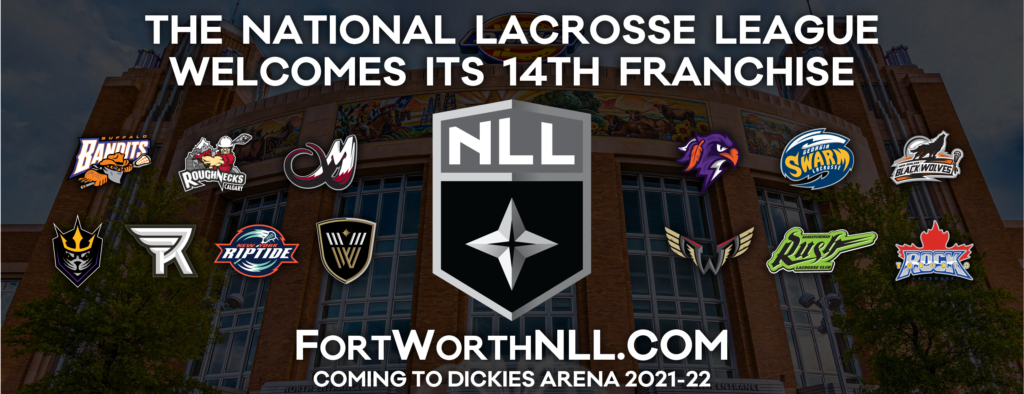National Lacrosse League Expansion...Past, Present, and Future
15 de Mayo de 2021 a las 05:04
Photo courtesy of InsideLacrosse.com
Article by Gary Groob IG: @ggroob
Columnist and Host of Spanglish World Networks
TORONTO. - With the recent Fort Worth expansion, and the move of New England to Albany, it is safe to say that Pandemic or not, the National Lacrosse League (NLL) won't let anything come between themselves, and the goals they have set for league growth.
When Nick Sakeiwicz took over as the NLL commissioner his mandate was to expand the league the same way he helped to expand Major League Soccer (MLS).
People who had been around the NLL had seen this movie before.
Give out franchises to questionable ownership groups for the sake of expansion, led to teams folding, or moving cities creating instability in the league. At their peak, the "old" NLL had thirteen teams, but in recent years had settled comfortably to a nine team league of stable franchises.
Enter Commissioner Nick Sakeiwicz...
Although the first couple of years he was more in the background, he wasn't just sitting in his office. Mr. Sakeiwicz was learning the league (the game, the teams, the fans), and was also fine tuning his blue print on expansion to fit the NLL.
What were the prerequisites?
Commissioner Sakeiwicz was looking for stability of the league first and foremost. To achieve this he would only look to expand with NHL/NBA ownerships or people with very, very deep pockets.
The first expansion added a billionaire to the league. Joseph Tsai, Owner of the Ali Baba empire and worth approximately 17 Billion dollars, was granted a team in San Diego (Seals). This also opened the southern west coast to the league for the first time in years. At the same time, Sakeiwicz brought a franchise back to Philadelphia (one of the original cities of the NLL dating all the way back to '74). This time however, the ownership group was Comcast, who also owned the NHL Flyers, and had the Wells Fargo Center ready for them to play.
Opening the coasts was important to the league, making sure the entire Continent of North America was included in this league.
Rochester's owner Curt Styres was looking to move his franchise to Halifax, Nova Scotia, but that would leave a hole in the storied NLL city of Rochester, what to do? A deal was struck with Terry Pegula of Pegula Sports and Entertainment, and owner of the Buffalo Bandits and Buffalo Sabres. His ownership group would now put an expansion team back in Rochester, NY, and though unorthodox, it worked. At the same time GF Sports (with proven experience managing live sports and entertainment properties both in the New York area and worldwide) was awarded a Franchise on Long Island, to play at the Nassau Coliseum.
Enter the Fort Worth expansion...
Bill Cameron (Part owner of the NBA's Oklahoma Thunder) headed the ownership group set to lead the Panther City Lacrosse Club, ready to play in Dickies Arena in Fort Worth, Texas.
The move of the New England Black Wolves to Albany (newly named the Firewolves), added Oliver Marti, a former pro lacrosse player himself, major invester in the Premier Lacrosse League (PLL), owner of Epoch lacrosse equipment, also forming the Connecticut-based healthcare hedge fund team CCI Healthcare at investment firm Columbus Circle Investors in 2001 and founded Akera Capital in 2018.
Where to next?
In Canada there are four spots the league is looking at...Edmonton, Winnipeg, Montreal, and Quebec City.
In the U.S. the league is looking to increase their exposure on the west coast with places like San Francisco, Seattle, and Las Vegas constantly as rumored destinations.
The departing of the New England team to Albany, leaves a hole on the east coast, and rumors of the Boston Bruins (NHL) looking to resurrect the Boston Blazers have surfaced.
The league will add more franchises but, as seen in the past with this management group, will do their due diligence first, and space it out to not destroy chemistry of the present teams (expansion drafts have teams losing two players each time). The goal to have twenty to thirty teams, moving the league eventually from part time to full time is well underway, but this is a marathon not a sprint.
Teams will be added a few at a time, a few years apart from each other, keeping balance while moving forward. As long as Sakeiwicz and his team stay true to their blue print, they will have stable franchises all over North America. The future looks to be bright, and exciting for this league.




Comentarios
escribenos